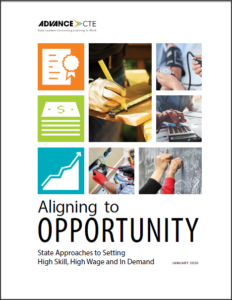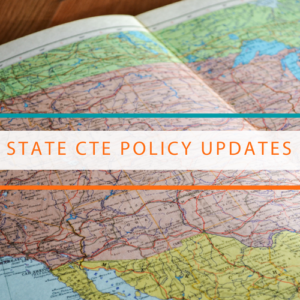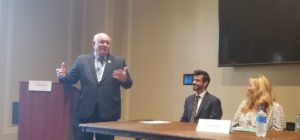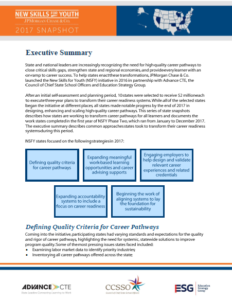 The Strengthening Career and Technical Education for the 21st Century Act (Perkins V) places a strong emphasis on the alignment of Career Technical Education (CTE) programs of study with state, regional and local economies. The legislation requires Perkins-funded programs to prepare students for “high-skill, high-wage, or in-demand occupations.” These terms — high skill, high wage and in demand — are foundational to Perkins V, appearing in both the purpose of the law and the definition of CTE.
The Strengthening Career and Technical Education for the 21st Century Act (Perkins V) places a strong emphasis on the alignment of Career Technical Education (CTE) programs of study with state, regional and local economies. The legislation requires Perkins-funded programs to prepare students for “high-skill, high-wage, or in-demand occupations.” These terms — high skill, high wage and in demand — are foundational to Perkins V, appearing in both the purpose of the law and the definition of CTE.
As with many Perkins V requirements, the responsibility of defining these terms rests solely with states, providing them with a major opportunity to set a meaningful bar for determining which career opportunities anchor their CTE programs. The stronger focus on labor market alignment compels state CTE leaders to ensure that all program offerings are relevant to today’s economy and that learners will participate in CTE programs with data-driven and validated labor market value.
Advance CTE newest paper, Aligning to Opportunity: State Approaches to Setting High Skill, High Wage and In Demand, describes some approaches that states are taking to partner across agencies to access and review labor market information; develop definitions for high skill, high wage and in demand; provide local flexibility, while maintaining guardrails; and disseminate the information widely to key audiences.
For example:
- District of Columbia’s Office of the State Superintendent of Education led a collaborative process, engaging the Workforce Investment Council, Department of Employment Services, industry partners and other key stakeholders to identify data sources and set their definitions for high skill, high wage and in demand.
- Nebraska’s H3 site provides the state definitions of high wage, high skill, and high (in) demand, as well as a search tool for identifying those occupations at the state or regional level.
- Texas allows for local flexibility through a regional program of study application process that enables locals to present regional LMI to justify a program of study, which, once approved, can then be offered by any district within the region.
- OhioMeansJobs is an initiative developed through the state’s Office of Workforce Transformation. In addition to the state’s identified in-demand jobs, the site also offers a great deal more for students and job-seekers, such as a career interest inventory, job and company search engines and other career exploration tools.
For more, including specific definitions used by the states mentioned above and others, read Aligning to Opportunity: State Approaches to Setting High Skill, High Wage and In Demand.
The report was made possible by the generous support of the Joyce Foundation.
Kate Kreamer, Deputy Executive Director


 Through NSFY, Delaware, Kentucky, Louisiana, Massachusetts, Nevada, Ohio, Oklahoma, Rhode Island, Tennessee and Wisconsin took action to:
Through NSFY, Delaware, Kentucky, Louisiana, Massachusetts, Nevada, Ohio, Oklahoma, Rhode Island, Tennessee and Wisconsin took action to: As part of this initiative, Advance CTE has committed to developing resources to help state leaders close equity gaps in CTE. To provide state leaders with promising practices, Advance CTE added three new equity-focused policy profiles to the
As part of this initiative, Advance CTE has committed to developing resources to help state leaders close equity gaps in CTE. To provide state leaders with promising practices, Advance CTE added three new equity-focused policy profiles to the  Throughout history, and continuing today, learners of color, low-income learners, female learners and learners with disabilities have been historically tracked into terminal vocational programs leading to jobs with uncertain promise of economic growth and prosperity.
Throughout history, and continuing today, learners of color, low-income learners, female learners and learners with disabilities have been historically tracked into terminal vocational programs leading to jobs with uncertain promise of economic growth and prosperity. The majority of 2018 state legislative sessions have come to a close. During these legislative sessions, states enacted budgets that illustrate a continued commitment to invest in Career Technical Education (CTE) and opportunities for learners to earn credentials that translate into high-skill, in-demand occupations.
The majority of 2018 state legislative sessions have come to a close. During these legislative sessions, states enacted budgets that illustrate a continued commitment to invest in Career Technical Education (CTE) and opportunities for learners to earn credentials that translate into high-skill, in-demand occupations. Earlier this summer, Advance CTE in partnership with Education Strategy Group (ESG) and the Council of Chief State School Officers (CCSSO), released
Earlier this summer, Advance CTE in partnership with Education Strategy Group (ESG) and the Council of Chief State School Officers (CCSSO), released  What can state leaders do to expand access to high-quality career technical education (CTE) in rural communities? That was the focus of an event held last Thursday by the Congressional CTE Caucus, in coordination with Advance CTE.
What can state leaders do to expand access to high-quality career technical education (CTE) in rural communities? That was the focus of an event held last Thursday by the Congressional CTE Caucus, in coordination with Advance CTE.  How can state and local leaders tackle these challenges? During the event, Dr. Marcie Mack — state CTE director for Oklahoma, spoke about
How can state and local leaders tackle these challenges? During the event, Dr. Marcie Mack — state CTE director for Oklahoma, spoke about  Jan Hanlon, executive director for the Mountain State Education Service Cooperative, discussed how West Virginia is tackling access challenges through Simulated Workplace programs. Through Simulated Workplace, more than
Jan Hanlon, executive director for the Mountain State Education Service Cooperative, discussed how West Virginia is tackling access challenges through Simulated Workplace programs. Through Simulated Workplace, more than Some states have involved Career Technical Education (CTE) from the onset and others are now looking to ensure CTE is part of their overall strategy. The
Some states have involved Career Technical Education (CTE) from the onset and others are now looking to ensure CTE is part of their overall strategy. The  What defines a high-quality career pathway? Is it alignment to labor market needs and career opportunities? The quality and qualifications of teachers and faculty? Access to meaningful, aligned work-based learning experiences? Perhaps all of the above?
What defines a high-quality career pathway? Is it alignment to labor market needs and career opportunities? The quality and qualifications of teachers and faculty? Access to meaningful, aligned work-based learning experiences? Perhaps all of the above?